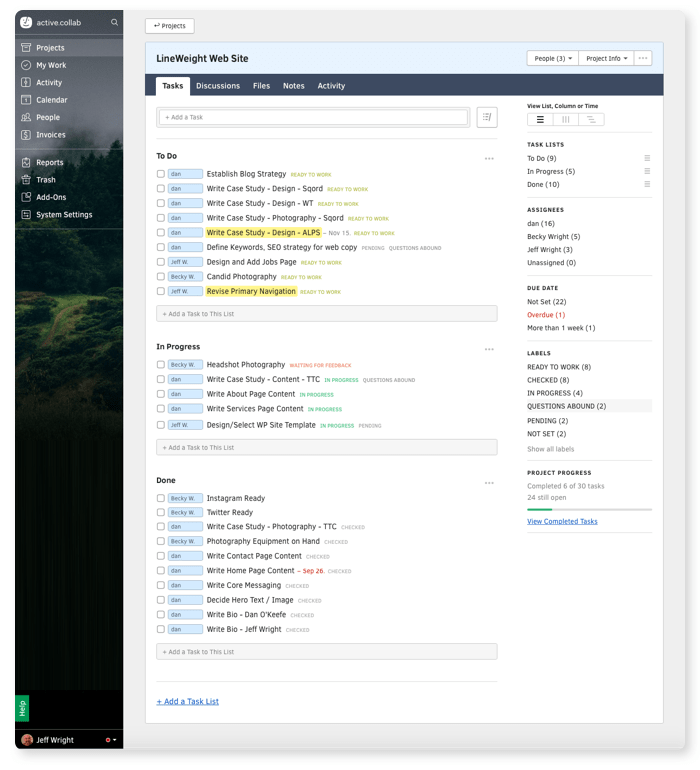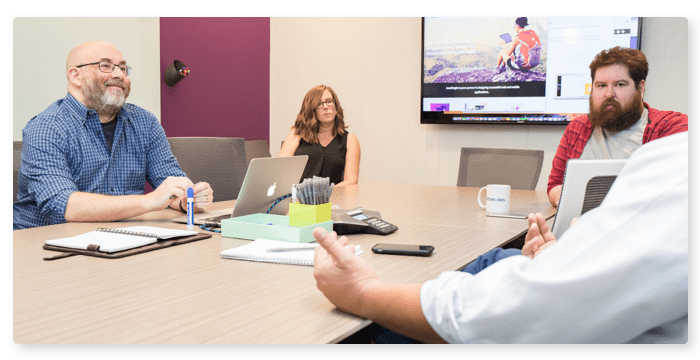Customer story written by Jeff Wright, owner of mobile digital agency LineWeight
As a web and mobile design agency that also provides copywriting, marketing, photography, here at LineWeight, we needed a project management system that could not only handle the diversity of our project types but also seamlessly allow them to intertwine. It should provide clarity for our internal team, external resources, and our clients as well.

LineWeight website project
LineWeight was founded in early 2017 on a preliminary identity, website, and brand to hit the ground running. As the year progressed, it became clear we needed to polish up everything we were doing for the long term. That meant a new logo, new messaging, new website, new copy, and new photography. Everything LineWeight does well, we now needed to do for ourselves. And fast.
We started with a brainstorming session about what each of these needs meant, how they'd overlap, where dependencies might lie, and what would be our challenges. We began writing the necessary tasks on post-it notes and filling up a whiteboard. This process allowed us to talk about the tasks, and consolidate or expand where needed. It allowed us a great insight into dependencies and the sequence by which the work would need to be completed. And, of course, it showed us just how much we really needed to do in a short amount of time.
After that, we transferred the post-it notes into ActiveCollab as tasks and assigned each to a team member. And now, our project looks like this:

The immediate needs, we moved right into "In Progress" and started working, then, as tasks were moved further, we could see that the necessary tasks weren't spread out among our team members well.
We had bottlenecks around some of our early needs, where too much was dependent on one or two people. As ActiveCollab makes this visible by displaying the assignee's name right next to the task, at a glance, we knew we had to re-think and re-assign some of the early dependencies. And it's incredible when you have that kind of clarity, it becomes surprisingly easy to realize that thing A, B, and C don't need to be done before D. Finally, ActiveCollab allowed us to detect poorly-utilized team members who ultimately provided help in unexpected ways.
How do we organize our projects?
Our organizing principle is based on handling projects, rather than departments: Each project may contain elements of UX design, visual design, front-end development, content, photography, marketing...
As such they are organized based on a modified Kanban approach, and every task is organized into one of three categories: "To Do", "In Progress" and "Done."

Each task is assigned to a single team member that will see to its completion, usually based on the type of work that it entails, and - when necessary - a due date. Tasks are defined by a clear title, a very brief success criteria, and any necessary details needed to complete the job successfully. We prefer to keep it short, but ActiveCollab is very strong when it comes to allowing lots of detail, discussion, and history around a task.
Additionally, each task is given a label. Some of our labels include "Pending", "Ready to work", "Questions Abound", "Waiting for Feedback", "Lowish Priority". These give color to tasks in any of the above categories, and, in combination with the category, really let us see the status of any task at any time.
As a team member works a task, they move it from "To Do" into "In Progress" and manage the labels accordingly. We have a weekly walk-through of everything we have in progress, and each team member uses the "My Work" list extensively, and labels help as well.
Tasks in Done are not marked as complete until they no longer need to be visible to the people working the project.
This is a simple structure and a simple flow, but that simplicity allows excellent clarity for is, internally, as well as any external client or partner who might be unfamiliar with our process. Anyone can see, at a glance, where things are.
